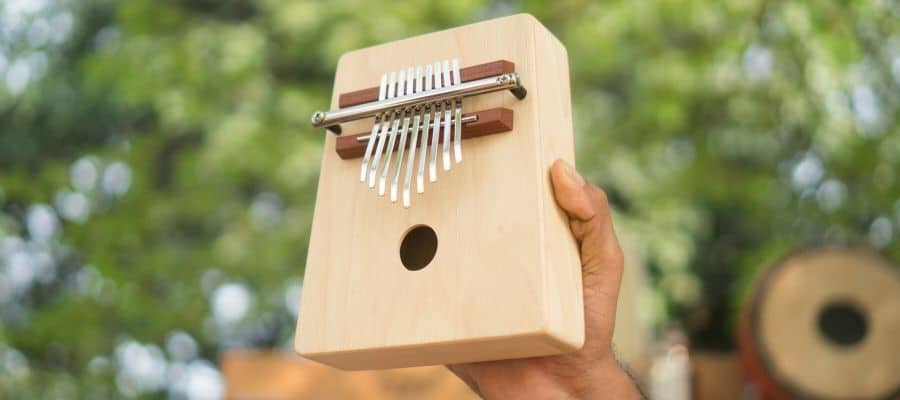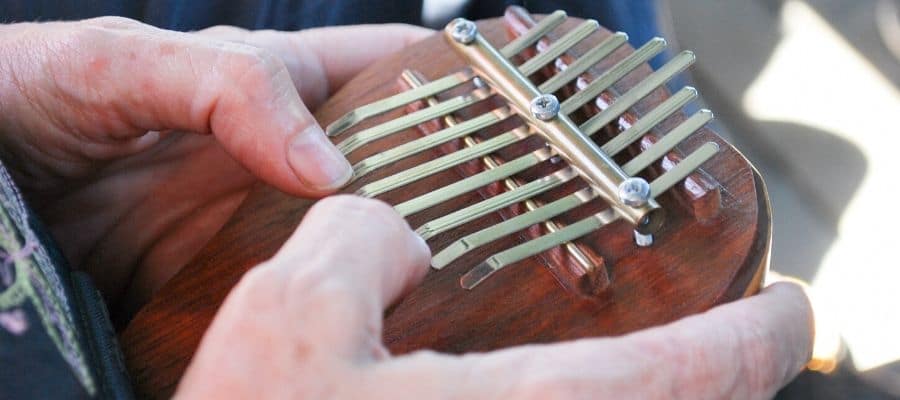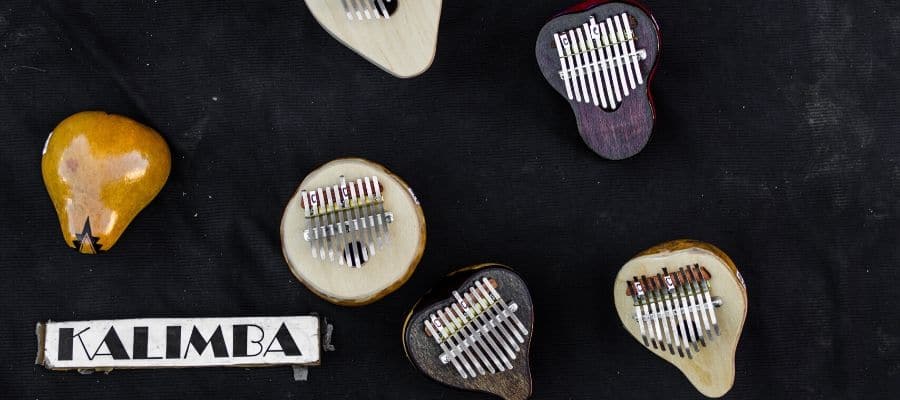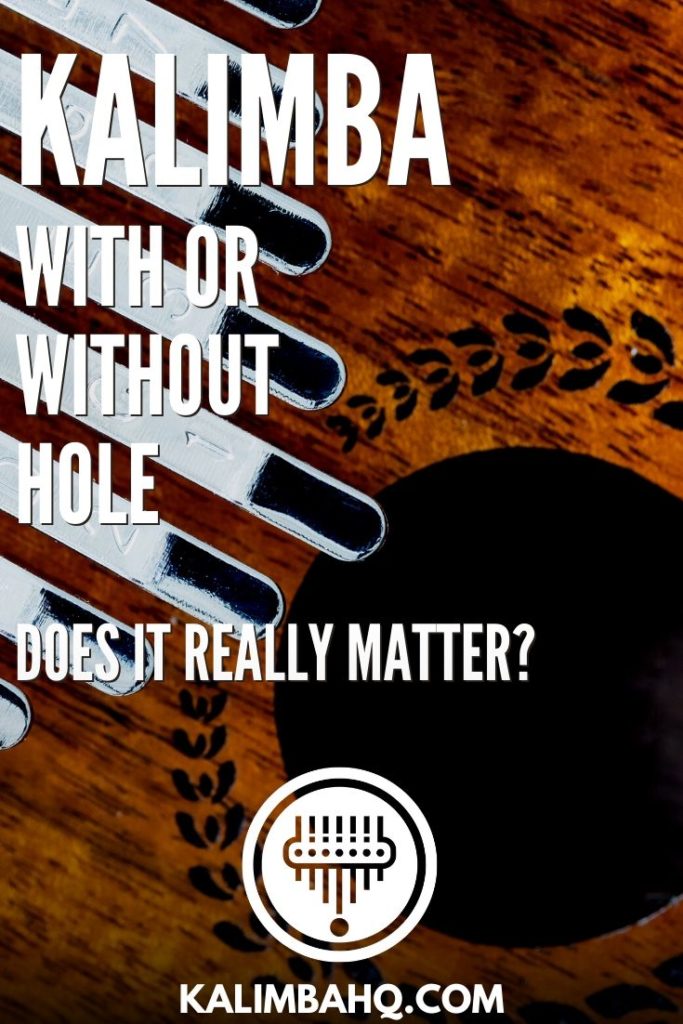Anyone interested in playing the kalimba probably noticed that some models have a hole inside the box. Furthermore, some instruments have additional holes on the back, while others have none.
The main question many ask is whether the existence of holes makes any difference. The short answer is yes. Kalimbas with holes will sound different, and you can use several different techniques to play that would otherwise be unavailable to you.
But this doesn’t necessarily mean that the instrument with a hole is superior, and both types have their own advantages and disadvantages.
Kalimbas With A Hole

The most common kalimbas you’ll find have a hole in the middle of the wooden box. The reason for this is to amplify the sound similar to how acoustic guitars have sound holes. Furthermore, these instruments are made of wood, and manufacturers will decide on the type of wood they want to use.
Usually, it will be mahogany, bamboo, acacia koa, or any other they see fit. Regardless of the wood type, the box will be quite thin so it can properly vibrate once you start playing.
The mechanics behind the kalimba is simple. Plucking the tines will cause the top board to vibrate, and the sound will be amplified. The opening will allow you to hear each note clearly and loudly.
The most common type of sound hole is round, but it is possible to find something different and more unique as well. Sometimes, a sound hole will be in the shape of the heart or some animal.
While the shape might contribute to the sound properties, it is not something that you will notice, and the type of wood will play a more important role in the quality of sound.
Finally, some kalimbas have two extra holes on the backside, and they can be used for additional techniques. Based on which tines you are playing, you can cover either the left or right back hole to create an effect that’s similar to a pedal.
The front hole, on the other hand, can be used for vibrato.
While most kalimbas with a hole have trapezoid shape, you can encounter other models as well. It is even possible to find a perfectly round kalimba with a silicone sleeve that looks like a bunny!
Pros And Cons Of Kalimbas With A Hole

The main advantage of kalimbas with a hole is its acoustic properties. These thumb pianos are more similar to the classic instruments like violins, guitars, and mandolins, and woodworking is often incredible.
You will get a beautiful instrument that you’ll be able to enjoy and the sound coming out of them is determined by the quality of wood.
A player can spend time experimenting with different types of wood to see which one has a brighter tone if that’s something they enjoy.
Naturally, they will be able to add something more to their playstyles like vibrato and wah, as I mentioned earlier.
But having a wooden instrument requires care, and you won’t be able to just leave it be if you want it to last. The common problem with these instruments is the rust that can appear on tines, and you might need special oils to keep the wood healthy.
The whole cleaning process is another thing you’ll need to consider, as well as the humidity of the room. You will probably need to get a case (if you don’t have one already) to ensure that the instrument is not damaged by accident.
Kalimbas Without A Hole

The second type of kalimba is designed without a hole. Now, this type is probably less common, but you can still easily find models like this. Instead of the resonating box, these kalimbas have a board.
Companies creating kalimbas tend to experiment with materials, and here, you will encounter a lot of freedom when it comes to building the board.
Some kalimbas are made of wood, where the material will still resonate with tines, but the sound will be a lot quieter. On the other hand, it’s not rare to find a thumb piano made of acrylic or glass which will add something different to the equation.
Since the shape of the board is not as important as with resonators, you can find more exciting shapes that will allow you to get a more personalized instrument that may fit your needs better.
Moreover, some kalimbas are a lot smaller than the resonator ones, which is something many will enjoy. You’ll be able to carry your instrument easily and some models can fit in your pocket.
Pros And Cons Of Kalimbas Without A Hole

Kalimbas that are using a board instead of the resonating box is easy to carry. You won’t have any problems finding a place for them, and you can even put them in the pocket.
Another major advantage when it comes to the size is that these are easier for playing. If you have smaller hands, or you plan on getting a kalimba for your child, they can easily learn how to play.
They won’t need to struggle with the size of the instrument, and it will comfortably stay in their hands.
However, the player won’t be able to use any additional techniques, and these often have a fewer number of tines. The volume on the solid-body kalimba is quieter, but the volume is more even.
While rust is still a problem with this type of thumb pianos, cleaning them is a lot easier. This is especially the case with kalimbas made of acrylic or glass, and you can just wipe them after each session.
These are also more durable, and might be perfect for people who tend to drop things. Even if you make a dent on the wood, it won’t make any difference to the quality of sound.
Furthermore, you won’t need to worry about special oils, and if they will work well with the specific wood type.
With or Without Hole – Which One To Get

There is no doubt that the sound will be different between the two. But this is something that’s completely subjective. Some people enjoy the richer sound coming from wood, while others love sound properties coming from acrylic.
Kalimbas with a hole will have a lot more sustain and richer sound. Whether the tone is bright or dark will mostly depend on the material of the instrument. You can check the link below to hear how kalimba sounds with a resonator.
The song is recorded by the incredible April Yang, and if you never had experience enjoying her songs, you will undoubtedly fall in love with her channel.

But this doesn’t mean that the sound coming from the other kalimbas is weak. They can sound almost equally beautiful. To make everything as clear as possible, check out the link to hear the kalimba with a board instead of the resonating box.

If you don’t mind the size of the instrument, and if you are looking for an authentic sound, a kalimba with a resonator might be a great option for you.
On the other hand, you can hear that even without the resonator, the instrument still sounds beautiful. It is easier to play, and you can still create beautiful music.
In the end, it all comes down to personal preferences, and both types can be amazing if you invest enough practice and care about your music.
Other Options You Can Try

Having to choose between the hole and no hole is not your only option. There are many other types of kalimba available on the market, and you might be interested in checking them out if you like differences in acoustic properties.
Some instruments have a pickup that allows the player to plug them into the amplifier or a speaker. This way, you’ll have a lot easier time recording the kalimba, and you can even play it live.
The idea behind these electric kalimbas is to allow players to be a part of the band without having to worry about microphones or if anyone will hear them.
Another exciting option is kalimbas with resonator frames. Instead of having a box, these have only a frame of the resonator, which means that the bottom side is open.
To play the kalimba with a frame, you will need to keep it close to the surface like the table, and you can create the wah effect by tilting it one way or the other.
Sansula is the company that creates these, and you might enjoy playing with such kalimba. In a way, you could say that these have a hole since the bottom side is missing.

Summary
Kalimbas come in all shapes and sizes, and probably the most apparent difference is that some have a sound hole while others don’t.
Instruments with a resonator will have one or more holes, and these will allow players to try out different techniques like wah and vibrato. Furthermore, the resonator tends to make notes louder, and this change in volume is especially apparent in lower keys.
Solid-body instruments, on the other hand, can experiment with different materials, and you can find kalimbas made of wood, acrylic, or any other material. The sound is a bit quieter, but the volume is more even across the notes.
Another major difference between these two types is that the solid-body instruments are a lot smaller. You can easily play them even if your hands are smaller. The ones with a resonator box tend to be larger, heavier, and playing them for a longer period of time might be a problem for some.
While there is a difference in the sound, besides volume, there is no doubt that some people will prefer one type or the other.
In the end, it all comes down to personal preferences, and you should get the type you find best. Both types of kalimba are beautiful, and they will sound amazing if you keep practicing.
If you found this article useful you may want to save this pin below to your Kalimba board

Recent Posts
How To Play “How Deep Is Your Love” On Kalimba - Tabs Included
There are so many incredible songs you can learn to play on Kalimba, but if you are a beginner, the best idea would be to go easy. But finding a perfect song to learn is never easy. Fortunately, this...
Jingle Bells is among the most commonly sung (and the most well-known) songs in the world. Everyone heard of this one, and it is one of the go-to songs for beginner musicians. Regardless of...

